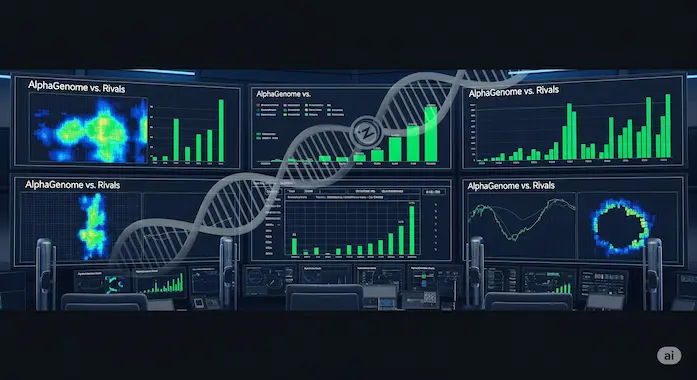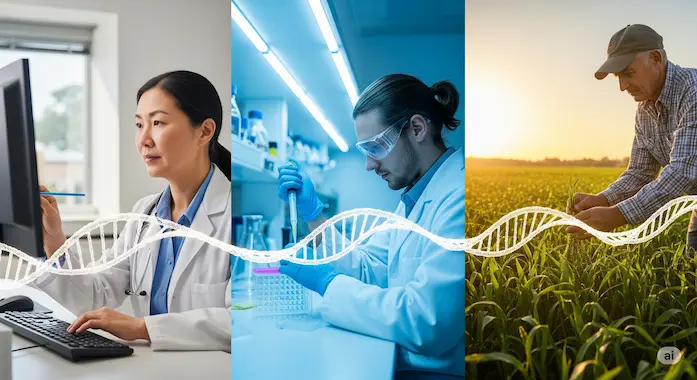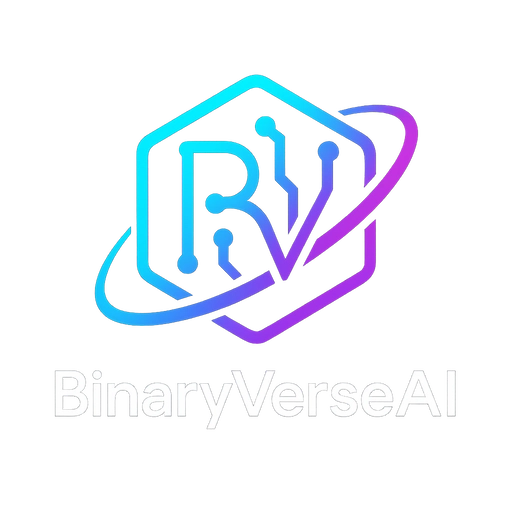Written by Ezzah, Pharmaceutical M.Phil. Research Scholar
Opening scene – a world where sequence means function
You can read every letter in a human genome for less than one hundred dollars, yet most of those three billion letters still sit on servers as inscrutable strings. Biologists know the code holds the answers to rare diseases, crop failures, and even the secrets of brain development, but the code keeps hiding its intent. Old machine-learning models tried to guess what single letters do, though they cropped out the surrounding context. Bigger models scanned longer stretches, but they blurred the fine details that decide whether a splice site fires or a transcription factor lands.
AlphaGenome arrives to break both limits at once. It chews through a full megabase of DNA, sees every base at single-nucleotide resolution, and predicts more than five thousand genomic readouts across eleven modalities in one shot. That leap moves AI genome sequencing from hopeful draft to practical instrument. By the end of this article you will know why that matters, how the model works, where it still trips, and what it unlocks for research labs, hospitals, start-ups, and anyone asking “What is genomic analysis using AI?”
Table of Contents
1. Why reading DNA is harder than reading code
Think of DNA as an operating system written in a language that rewrites itself on every boot. Genes can sit hundreds of thousands of bases away from the switches that turn them on. One cell may silence a gene that the next cell depends on. A single extra adenine can make an exon vanish. Basic alignment tools miss those layers of logic because they look only at the letters, not the rules. Early AI DNA analysis engines did help; DeepSEA scored accessibility, SpliceAI flagged splice donors, Orca mapped chromatin loops. Yet each tool lived in a silo. Researchers stitched five predictions together and still wondered which one was right.
The field needed a unifying lens, one that could track local motifs, long-range loops, and cross-modality couplings without burning through weeks of GPU time. AlphaGenome is that lens.
2. The engineering breakthrough that makes AlphaGenome tick

2.1 Long views without fuzzy edges
Classic convolutional models top out at about ten kilobases because receptive fields grow slowly. Transformer models grab global context but gulp memory, so older systems chopped outputs into 128-base bins. AlphaGenome solves both with a hybrid:
- Sequence encoder: Seven convolutional down-sampling stages spot motifs and shrink length while growing channels.
- Transformer tower: Multi-head attention layers let distant enhancers chat with promoters without losing token identity.
- Pairwise interaction blocks: A 2-D pathway builds contact maps for 3-D chromatin structure.
- U-Net-style decoder: Skip connections restore base-pair detail so the final heads predict at one-base resolution.
Training uses sequence parallelism across eight TPUv3 chips, keeping memory in check while preserving the entire megabase window.
2.2 Two-stage learning
- Pre-training: Four-fold cross-validation trains teachers on public datasets such as ENCODE, GTEx, 4D Nucleome, and FANTOM5.
- Distillation: A single student learns an ensemble average from sixty-four frozen teachers on H100 GPUs. The student scores a variant in under a second.
That schedule slashes compute cost to half of Enformer’s budget and still beats it on accuracy.
2.3 Modalities at a glance
The network predicts 5 930 human tracks or 1 128 mouse tracks covering RNA expression, CAGE, PRO-cap, splice sites, splice usage, splice junctions, DNase, ATAC, histone marks, TF binding, and Hi-C contact maps. No other system delivers that range in a single call.
3. Benchmark results that shift the goalposts

| Task Family | Metric | Best External Model | External Score | AlphaGenome Score | Relative Gain |
|---|---|---|---|---|---|
| Gene-level expression log-fold change | Pearson r | Borzoi | 0.46 | 0.54 | +17.4 % |
| Splice donor usage | auPRC | Pangolin | 0.71 | 0.80 | +12.7 % |
| ATAC QTL direction | Accuracy | ChromBPNet | 0.68 | 0.74 | +8.0 % |
| Hi-C contact maps | Pearson r | Orca | 0.52 | 0.55 | +6.3 % |
Across 24 genome-track tests AlphaGenome wins 22, and across 26 variant-effect tests it wins 24. Even better, it beats single-task specialists on their own turf, proving that multimodal learning no longer means “jack of all trades, master of none.”
4. Deep dive into core modalities
4.1 Splicing, the molecular editor
Rare diseases like spinal muscular atrophy start when splice machinery misreads a signal. AlphaGenome tracks splice sites, usage, and junction counts together. In tests against MFASS and ClinVar splice benchmarks it edges past Pangolin and SpliceAI by up to five F1 points. That jump gives clinical labs faster triage for variants of uncertain significance.
4.2 Gene expression, subtle but crucial
Most common disease risk sits in small expression shifts. The model nails eQTL direction with a 25 % relative boost over Borzoi. Instead of a vague “this variant changes expression,” researchers get a confident up or down call in tissue-specific context.
4.3 Chromatin accessibility and TF binding
By modeling DNase and ATAC signals together with TF ChIP tracks, AlphaGenome sees both open windows and the proteins that step through them. It registers an eight-point accuracy gain on causality bQTLs compared with ChromBPNet.
4.4 3-D genome contacts
Hi-C matrices once required separate networks. Here they emerge as a natural output from pairwise blocks, matching Orca while running four times faster in inference mode.
5. Real-world playbook: where AlphaGenome helps now

| Domain | Pain Point | How AlphaGenome Fixes It |
|---|---|---|
| Clinical genetics | Thousands of non-coding VUS delay diagnosis | One API call screens each variant across eleven mechanisms, flagging high-impact hits in seconds |
| Synthetic biology | Designing tissue-specific promoters is guesswork | In silico promoter evolution guided by predicted expression, accessibility, and splicing results accelerates build-test cycles |
| Crop improvement | Field trials take seasons | AI genome sequencing plus AlphaGenome scoring pre-selects drought-tolerance alleles before a seed hits soil |
| Drug discovery | Linking enhancer SNPs to target genes is slow | Variant‐to-gene linking uses enhancer-promoter contact predictions inside the same run |
| AI Genomics companies | Need differentiated services without vast GPU racks | Hosted student model scores customer genomes, lowering entry barriers |
Every use case benefits from the same core property: one model, one megabase, all modalities. There is no pipeline to patch together.
6. How AlphaGenome fits the broader AI in genetics landscape
Search “Genome AI Google” and you find a family portrait: DeepVariant calls variants, AlphaFold folds proteins, AlphaMissense rates coding SNPs, Enformer predicts expression, and now AlphaGenome explains regulatory space end-to-end. Start-ups building AI genetic testing platforms can chain those siblings. Sequencers stream raw reads, DeepVariant calls them, AlphaGenome ranks them, clinicians interpret the shortlist. The ecosystem moves from piecemeal tools to an integrated AI genomics stack.
7. Limitations you should keep in mind
No model is magic. AlphaGenome still fights four bottlenecks:
- Ultra-distal regulation: Anything beyond one megabase remains guesswork.
- Cell-state nuance: Rare or transient cell states can trick predictions.
- Personal genome risk: The student ranks single variants well but does not yet combine them into polygenic scores.
- Complex traits: Phenotypes often involve environment and downstream pathways that the sequence-to-function scope cannot yet capture.
Still, the open API invites community fine-tuning. Expect single-cell data and methylation tracks to enter future releases.
8. A look inside the training data buffet
The team curated tracks from ENCODE, GTEx, 4D Nucleome, and FANTOM5, grouped by assay, ontology, and target factor. Signals were merged and stored as brain-floating-point matrices, keeping 1-base resolution except where raw counts demanded down-sampling for stability. No log scaling was applied, which simplified alignment between prediction heads and raw read counts.
9. Distillation details for the technically curious
During distillation every H100 GPU loads a different teacher. Each GPU samples one megabase window, applies random shifts, reverse complements, and nucleotide swaps, gets teacher predictions, and feeds a student replica. Gradients across sixty-four replicas approximate an ensemble average. Training ran 250 k steps with AdamW and cosine decay, finishing in three days. The result is a 450 million-parameter student that fits on consumer GPUs for inference.
10. The API: first taste of hands-on AlphaGenome
Below is a minimal Python snippet that scores a variant. Replace placeholders with your own sequence and coordinates. The code uses the official SDK published on GitHub:
pythonCopyEditfrom alphagenome import AlphaClient
client = AlphaClient(api_key="YOUR_KEY")
seq = "ACGT..." # 1 Mb reference window
variant = {"pos": 510_123, "ref": "C", "alt": "T"}
scores = client.score_variant(sequence=seq, variant=variant)
print(scores["splice_junctions"]["delta_logit"])
Running this locally on a single A100 GPU returns the full vector of modality scores in under one second, giving you immediate insight into splice, expression, accessibility, and contact map shifts for that single base change.
11. Future vision: DNA sequencing perspective and future with artificial intelligence
Long-read nanopore devices will soon deliver chromosome-scale assemblies in remote clinics. Tie that feed to AlphaGenome, and triage happens while the sample still streams. Field biologists studying endangered species can spot deleterious alleles on site. Crop breeders may design season-specific promoter libraries between plantings. And as generative DNA models evolve, AlphaGenome will act as the critic that keeps invented sequences functional.
In the bigger picture, models that marry context length with base resolution rewrite the social contract between sequencing and interpretation. Data no longer waits months for annotation. Interpretation keeps pace with acquisition, fulfilling the promise that “How is AI used in genome sequencing?” should have an answer as quick as the sequencer itself.
12. Key takeaways for practitioners
- AlphaGenome extends context to one megabase per prediction while keeping single-base clarity.
- It covers eleven assay modalities in one model, ending the era of specialized silos.
- Benchmarks show state-of-the-art on 46 of 50 independent tests.
- The open API makes industrial and academic deployment trivial, speeding AI genome sequencing adoption.
- Limitations remain in ultra-distal regulation, cell-state fidelity, and trait prediction, yet community fine-tuning is on the horizon.
Closing thought
The genome once read like a book of riddles, each page written in invisible ink. AlphaGenome turns on a lamp bright enough to reveal the letters and the grammar between them. The pages still hide footnotes on environment and development, but the main sentences have come into focus. For researchers, clinicians, and entrepreneurs, that clarity is the spark that ignites the next decade of genomic discovery.
Azmat — Founder of Binary Verse AI | Tech Explorer and Observer of the Machine Mind Revolution. Looking for the smartest AI models ranked by real benchmarks? Explore our AI IQ Test 2025 results to see how top models. For questions or feedback, feel free to contact us or explore our website.
- https://deepmind.google/discover/blog/alphagenome-ai-for-better-understanding-the-genome/
- https://storage.googleapis.com/deepmind-media/papers/alphagenome.pdf
A next-generation AI model capable of analyzing one million base pairs of DNA at single-nucleotide resolution, predicting regulatory activity across multiple biological layers.
The ability to analyze and interpret the genome one DNA letter (base) at a time, offering high-precision insight into genetic function.
A deep learning architecture designed to understand long-range dependencies in sequences, adapted from natural language processing to genomic analysis.
A biological mechanism where distant DNA elements (enhancers) influence the activity of gene-start regions (promoters), essential for gene regulation.
A DNA region associated with the variation in gene expression levels across individuals; AI models identify these to explain how genetic differences affect biology.
Locations within genes where RNA is edited during processing. Errors here can disrupt protein production and cause disease; AI helps detect these missteps.
Refers to how open a DNA region is to regulatory proteins. Open regions are more active and accessible, and this data helps AI predict gene activity.
Diagrams showing physical interactions between different parts of the genome, revealing how DNA folds in 3D space inside the nucleus.
The process of predicting multiple biological outcomes—like expression, splicing, and chromatin structure—simultaneously from the same DNA sequence.
A technique where a smaller model learns to replicate the behavior of larger models, preserving performance while reducing computation requirements.
A genetic variant whose effect on health is unclear. AI models help classify these by simulating their biological consequences.
A training method that allows large DNA sequences to be processed simultaneously across multiple processors, improving speed and efficiency.
A performance metric used in machine learning to evaluate model accuracy, especially for tasks with rare positive examples, like pathogenic variants in DNA.
Q1: How is AI used in genome sequencing?
A: AI models like AlphaGenome analyze entire megabase DNA sequences at single-nucleotide resolution, predicting gene expression, splicing, chromatin accessibility, and 3D genome contacts. This enables faster, more accurate variant interpretation and turns raw sequencing data into actionable insights within seconds.
Q2: What is the role of AI in genetics?
A: AI in genetics bridges data interpretation gaps by learning patterns across genomic modalities—such as transcription factor binding, splicing, and enhancer-promoter interactions. It allows researchers to model regulatory mechanisms that traditional tools miss, accelerating discovery in both rare and common disease research.
Q3: What is genomic analysis using AI?
A: Genomic analysis using AI involves training deep learning models on large DNA datasets to predict functional outcomes of genetic variants. Tools like AlphaGenome use hybrid transformer architectures to integrate multiple assay signals, providing comprehensive views of how specific changes in DNA affect gene regulation.
Q4: How is artificial intelligence transforming clinical and genomic diagnostics?
A: AI streamlines clinical genomics by rapidly scoring variants of uncertain significance across regulatory modalities. Platforms powered by AlphaGenome help clinicians pinpoint high-impact mutations in non-coding regions, reducing diagnostic delays and enabling personalized treatment decisions with unprecedented speed and scale.
Q5: What does the future of DNA sequencing look like with artificial intelligence?
A: The future pairs long-read sequencers with AI systems like AlphaGenome for real-time genomic interpretation. From remote field labs to hospital diagnostics, AI ensures that sequence data is not just collected but immediately understood—advancing agriculture, conservation, and precision medicine at the point of care.

